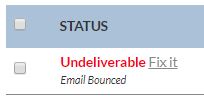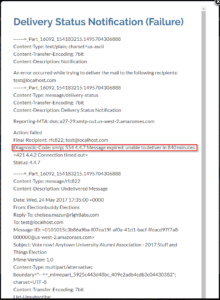Sep 5, 2017

Undeliverable email notices are truly one of the world’s greatest mysteries. “Why didn’t my voter receive their email notice?” is the toughest question I get asked. It’s a great question, but it is challenging to answer, because there are a lot of reasons why an email can seem to simply vanish into cyberspace.
We have introduced tools to try and assist our administrators with this throughout the years. But, we just released our most useful tool yet, and it would be a shame to not formally introduce it to you all. So, first we will take a look back at what features were in place before this new tool. Then, we will look at the brand-new tool that we just released. I hope you will be as excited about it as we are!
First Tool: the “Undeliverable” Voter Status

One of the first things that we did to try and make this issue easier for administrators to solve was giving them a clear indication of the voters that did not receive their email notice. This is the “Undeliverable” status, and you might see it in the voter list of your running election. It looks just like the image on the left.
Therefore, it became easier to identify which voters would not have received their notice.
Second Tool: the “Undeliverable History”
By now, you might be wondering, “Well, how do they know that the email was undeliverable?”
We know because ElectionBuddy received a _bounce-back message _for that voter. A bounce-back message is simply an automated email from an email server (like Gmail or Hotmail) that is sent to the original sender of the email, letting them know that the email was not received. Think of it like an ATM telling you that you cannot withdraw any more money for a specific reason. In that case, your card “bounced”.
So, our second tool is the “Undeliverable History”: this is where you can view the bounce-back message. To learn more about viewing a voter’s Undeliverable History, take a look at our handy support document!
Third Tool: the Newly Improved “Undeliverable History”

If you’ve ever taken a look at a bounce-back message, then you may not be so sold on how helpful viewing the bounce-back message is. If you haven’t, here’s a little taste.
That’s a lot of jargon to sort through, especially if you don’t know what you’re looking for. The red box in the image is the portion that would explain why the email bounced. Don’t think you would have found it on your own? That’s okay – now you don’t have to!
ElectionBuddy will now do all the dirty work for you. It finds the _bounce code _and tells you what that code means. A bounce code is a series of numbers that correspond to a specific reason for why the email was bounced. For example, in the above message, the bounce code was 4.4.7. A 4.4.7 means that the attempts to send the message timed out.
So, that means no hunting through the email to try and find the code. It also means no Googling to try and figure out what that code stands for. However, for those who are curious and would like to learn more about bounces and what they mean, Wikipedia is a great place to start!
Use the Undeliverable History tools to become a rock star election administrator!
This feature truly has such potential to make you, as the election administrator, look like a rock star. If I were an election administrator, I would:
- Reach out to voters who are showing as “Undeliverable” in my voter list before they realize they didn’t receive their voter notice.
- Not only does this make you look incredibly organized, it has impacts on your relationship with your members — there is a difference between being reached out to, and having to reach out, from the perspective of a voter.
- Reaching out to a voter makes them think that you care! Voters who feel important to their organization are voters who vote, so you can increase your voter turnout by putting just a little bit of effort in.
- Use this as an additional opportunity to update contact information for your members.
- Updated contact information for your organization’s members is important to have. You need it for next year’s election!
- Additionally, updated contact information means that you can continue to reach out to your members outside of the election in order to keep them engaged with the organization and make them more likely to vote next year.